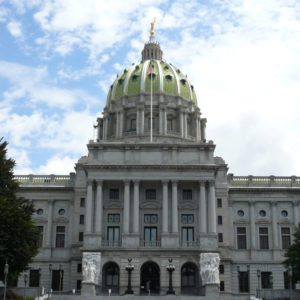Polarization, yes, competition, no?
That appears to be the case in Pennsylvania politics, where political passions have yet to translate into more competitive campaigns, at least where the state legislature is concerned.
Pennsylvania’s General Assembly elections this year are among the least competitive in the nation according to a new survey from the online political encyclopedia Ballotpedia.org. It ranks the Keystone State as number 34 out of 44 on the list for competitiveness in state legislative seats. (Some states do not have elections for their assemblies this year.)
The top three states with the most competition were Michigan, West Virginia and New Hampshire, while the least were Arkansas, Rhode Island and Illinois.
The ranking is based on three factors: the number of open seats in the election year, the number of incumbents who had an intra-party challenger in the primary election, and the number of seats in the general election in which there is only one major-party contestant on the ballot.
The ranking, however, is just one way to assess how competitive a state is when factoring in all seats that are up for election, and not just how thin a partisan majority in a house or senate chamber might be. This is underscored by the fact that even though many individual races across the commonwealth may not be competitive, the battle to win the partisan majority in the Pennsylvania House is still listed among Ballotpedia’s top “battleground” chambers across the country.
Republicans hold a 16-seat advantage in the House, and all 203 House seats are up for election this November. But Democrats have been eyeing a majority takeover, especially after long-serving Rep. Steve Barrar (R-Chester/Delaware) announced he would not run for re-election.
Barrar’s district voted for Romney in 2012, but swung to Clinton in 2016.
“While Democrats say they’ll fight for the seats still held by a dwindling number of Republican incumbents in Southeastern Pennsylvania, they may need to develop a message that can win beyond the suburbs,” the Inquirer reported soon after Barrar’s announcement. “In 2018, all of the Democrats’ House gains came in the Southeast: The party flipped 14 seats there but lost three elsewhere.”
Pennsylvania also is a kind of oddity in Ballotpedia’s “competitive” rankings in a way that doesn’t show up in the three metrics used.
“When you see the number of seats up for election without major party competition, it tends to be heavily in favor of one party over the other,” said Doug Kronaizl, who helped author the report for Ballotpedia. “So, if you look at a state like Massachusetts, out of 200 seats up for election, 140 are being contested only by Democrats compared to 19 of these safe seats for Republicans.”
“Or if you look at a state like Wyoming, you’ve got 75 seats up, 50 have only a Republican running, 5 are like that for the Democrats,” he told Delaware Valley Journal.
“In Pennsylvania, there’s a lot more parity between those metrics,” Kronaizl said. “Rather than it being a benefit to either the Democrats or the Republicans, you’ve effectively got 47 seats guaranteed to Democrats, and 42 seats guaranteed to Republicans, with the remaining 139 seats contested by both major parties.”
Term limits are helpful to promoting open seats, which would boost a state’s competitiveness as measured by Ballotpedia, but in this regard, Pennsylvania is in the majority with other states.
According to the National Conference of State Legislatures, only 15 states have term limits for their members of the state legislature.

